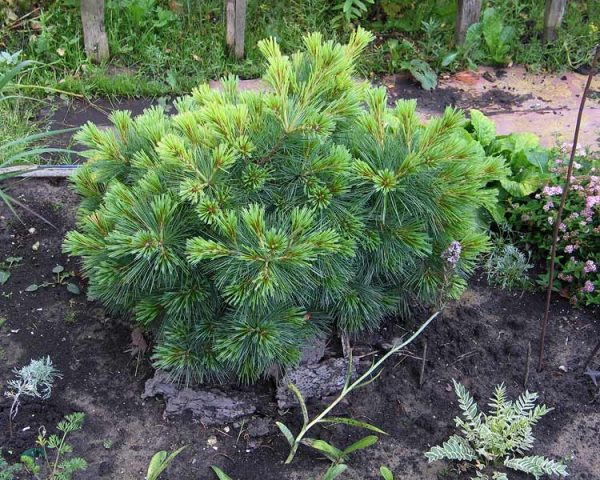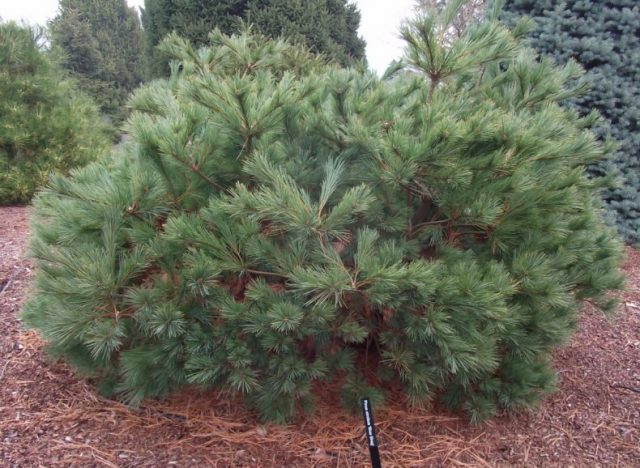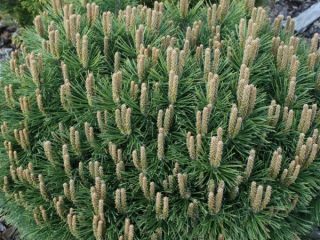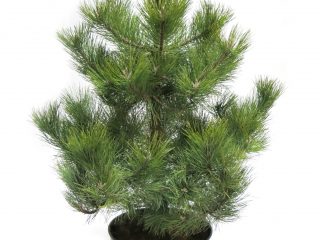Content
Pines have always attracted people with their unusual appearance and forest aromas. But most of them do not tolerate urban conditions well, and in private plots they turn out to be too powerful or light-loving. Weymouth pine is one of the most resistant to gases and smoke among its fellows. Compared to the more familiar Scots pine, it is not so demanding on lighting. In addition, it has many dwarf forms, quite suitable for growing even in a small area. In the article you can find not only a description and care of Weymouth pine, but also its most interesting types and varieties with photos.
Description of Weymouth pine
In Latin, this tree is called Pinusstrobus, which literally means “pine with cones.” And its Russian name comes from the surname of Lord Weymouth, who was the first to bring such a tree from America to Europe for planting on his estate at the beginning of the 18th century. Weymouth pine first came to Russia in 1793 and took root well in the climate of the Leningrad region.One of the names used to name it in Russia is eastern white pine.
In its homeland, North America, it can reach a height of up to 60-70 m, and the crown diameter is on average 1.5 m. The trunk thickness is up to 50-60 cm. The tree has a long life expectancy, up to 400 years or more .
In young trees, the crown usually has a regular shape, cone-shaped or spherical, depending on the species and variety. With age, pine becomes more spreading and takes on any crown shape, depending on the level of light and growing conditions.
Until 30 years of age, pine bark is smooth and has a light, grayish tint. Then it darkens and takes on a rougher appearance with grooves and cracks. Young shoots are brown-green, sometimes with a reddish tint. They often have barely noticeable whitish pubescence. Perhaps thanks to its presence, Weymouth pine received its second name - white.
Small, slightly resinous buds up to 5-7 mm long have a pointed ovoid-cylindrical shape. Thin and graceful needles are collected in bunches of 5 pieces. Their length can reach up to 10 cm. However, there are varieties of pine with rather short and weighty needles. Its color can vary from bluish-green to bluish. There are varieties with golden and silver needles, some varieties are able to change the color of the needles during the season.
The male cones of Weymouth pine are yellow, no more than 12-15 mm long. Females - ripen once every two years, have a narrow cylindrical shape and reach 18-20 cm in length. They often have a curved shape and hang in clusters of 2-8 pieces on fairly long petioles.
The seeds are small (5-6 mm), oval, red-brown, easily separated from the lighter wing. Trees begin to bear fruit when they reach 20-25 years of age.
Weymouth pine, especially its natural varieties, has the highest growth rates of all conifers. Only larch is ahead of it in this regard. Over the course of a year, shoots of some varieties can grow 20-40 cm. The trees are also characterized by good winter hardiness and can be grown throughout Russia except the northeastern regions. They also have good resistance to strong winds and snowfalls.
These pines perform well on various types of soils; they take root unsatisfactorily only on saline and highly calcareous lands.
Since in its homeland, in North America, Weymouth pine rarely grows alone, it is successfully combined in plantings with lindens, oaks, beeches, maples, hemlocks, fir, larches and spruces.
Weymouth pine varieties
According to the shape of the crown, Weymouth pine varieties are divided into pyramidal, weeping, bush-like, umbrella, and creeping. Based on the color of the needles, golden, silver, blue and variegated varieties are distinguished. Various dwarf varieties of Weymouth pine are very popular:
- Blue Shag;
- Brevifolia;
- Densa;
- Makopin;
- Minima;
- Prostrata;
- Pumila;
Auria
The main feature of this pine variety is the golden color of the needles, which is especially clearly visible on young shoots. The bark on them also has a yellow tint.
Otherwise, trees are not much different from their natural appearance.
Blue Shag
This variety is a representative of the blue varieties of Weymouth pine, otherwise called "glauka".The needles may have a bluish tint or light green with a silver stripe below. Blue Shag is classified as a dwarf variety, since the height of the pine does not exceed 1.8 m. At the same time, the width of the crown in adulthood can also reach 1.2-1.6 m. Despite its small size, this pine grows quite quickly - within a year the growth can be up to 3-4 cm.
It grows well in the sun, but is considered a fairly shade-tolerant form. It is not at all demanding on soils, but does not tolerate dry climatic conditions. But Blue Shag pine perfectly survives almost any frost. Has low resistance to blister rust.
Makopin
A somewhat similar variety, which is also classified as blue pine due to the corresponding color of the needles. It does not exceed 1.5 m in height and has an almost perfectly regular spherical crown shape. The branches grow densely, the annual growth rate reaches 7-8 cm.
This variety is very decorated with numerous twisting cones, up to 18-20 cm long. In youth they are green, in adulthood they turn brown. The needles are soft, long and thin, densely located.
Pine easily withstands shady conditions and poor soils, but does not tolerate stagnation of moisture or drying out of the soil at all.
Minima
This unique variety is also sometimes called Minimus. One of the shortest representatives of dwarf Weymouth pines. Evergreen bushes barely reach 0.8 m in height. Moreover, in the horizontal plane they can grow up to 1.5 m.
For many areas, this variety will become a real lifesaver. Moreover, the color of the needles of these dwarf bushes can change throughout the season.At first in the spring it is green with a slight lemon tint, and by the end of summer it acquires a light turquoise tint. The needles are very thin, but they are rigid and have a much shorter length than the standard type, about 25 mm.
The variety tolerates winter frosts well, but does not tolerate gas, smoke and general air pollution. In addition, the Minima variety is prone to rust infection and needle burning in the spring.
It is ideal to use pine to design heather or rocky gardens in the Japanese style, as well as retaining walls and small slopes.
Pendula
This variety is a classic representative of weeping varieties of Weymouth pine. The trees are distinguished by their shoots of an unusual arched shape, which, being at different distances from each other, are capable of whimsically twisting, forming an unusual crown that often touches the ground.
The trees can reach two meters in height, and the growth rate is significant - up to 20 cm per year. Having planted a Pendula seedling, within a few years you can admire the exquisite weeping forms of this Weymouth pine.
The needles can have both silver and bluish shades. The crown always extends much further in width than in height. Pendula has an increased requirement for sunlight and does not do well in partial shade. The buds may appear purple or grayish.
The variety is frost-resistant, but does not tolerate drought conditions well.
Fastigiata
This is one of the most unpretentious varieties of Weymouth pine. It is able to grow in almost any conditions, withstanding frosts, strong winds, shaded conditions and air pollution.
Pine grows quickly, 15-20 cm per year.Young trees initially retain a bushy spherical shape, but then stretch out strictly in a vertical direction and form a column-like shape. Mature trees reach 15 m in height and 2 m in width. The needles may be slightly curled.
How to grow Weymouth pine from seeds
Growing Weymouth pine from seeds is the cheapest and easiest way to get a lot of planting material from this plant. On average, about 52% of seeds are viable.
True, this method of propagation is unlikely to be suitable for varietal forms, since the likelihood of preserving their characteristics is not very high. But growing the main type of Weymouth pine is quite easy.
Since the embryos in pine seeds are in a dormant state, exposure to low temperatures is necessary to awaken them. To do this, the seeds are stratified before spring sowing. The operation consists of mixing the seeds with a small amount of wet sand and keeping them in this form at a temperature of +2-4 °C for about 4-5 months.
In spring, stratified seeds produce fairly friendly shoots. For this:
- The seeds are washed in cold water and slightly dried.
- Prepare a mixture of leaf soil, sand and peat in the ratio (3:1:1).
- Place the seeds in the prepared soil mixture to a depth of 1.5-2 cm.
- When crops are kept at a temperature of + 18-21 ° C, seedlings can germinate within a period of 2 weeks to 1.5 months.
- It is best to transplant grown sprouts into open ground in the fall or even in the spring of next year, if there is a bright, frost-free room where they can overwinter without problems.
Planting and caring for Weymouth pine
If there is not much land near the house and there is no time to tinker with seeds, then the easiest way is to buy a ready-made pine seedling of this species from a nursery. With proper care, it will soon turn into a beautiful tree or spherical shrub that can decorate any area.
Preparing seedlings and planting area
It is best to plant a young Weymouth pine plant as soon as possible after purchasing it. For planting, it is advisable to purchase trees with a closed root system, growing in containers. However, you can also use seedlings for planting, the root ball of which is wrapped in damp cloth. The main thing is that the roots are kept moist at all times, and the needles have an intense color of the shade that is inherent in the selected variety.
There should not be constant stagnation of water in the selected area - this can destroy the young tree. Some varieties of Weymouth pine can be planted in open areas without shade, others can grow and develop well in partial shade. The soil can be almost anything, but trees still develop better and suffer less on fertilized soils. It is desirable that the soil reaction be slightly acidic or neutral.
Landing rules
When planting, the root collar of the pine seedling should be flush with the soil surface. It is unacceptable to either deepen it or leave it above ground level.
Before planting, the hole is spilled with 10 liters of water with some addition of peat, humus and wood ash. It is better not to use chemical fertilizers - they can burn the roots of a young tree.
Watering and fertilizing
Even mature Weymouth pine trees of some varieties do not tolerate drought well. And young seedlings definitely require regular watering in the first year or two of their life. In hot summers, the soil should not dry out at a depth of about 30-50 cm. It is especially important to thoroughly shed the soil under the seedlings in the fall, before wintering. Each tree requires about 10-15 liters of water.
So that the tree can awaken safely in the spring, it is also watered, especially if there is little rain during this period.
It is advisable to feed Weymouth pine only a year after planting and use special complex fertilizers for conifers for this purpose. After 4-5 years, trees no longer need special feeding. It is much more important to control the optimal soil moisture in the summer.
Mulching and loosening
It is much easier to maintain soil moisture at the proper level if, from the very moment of planting, you mulch the ground around the seedling with any suitable organic material: peat, wood chips or bark, sawdust, crushed leaf humus. The thickness of the mulch layer should be at least 10-12 cm.
If in the summer it is necessary to loosen the soil and the mulch is mixed with the ground, then in the fall it will be necessary to add mulch material under the tree. Because it also serves as a source of additional nutrition for the tree and smoothes out temperature changes at soil level.
Trimming
The usual heavy pruning is not applied to Weymouth pine. If you want to influence the formation of the crown, then in the summer you can shorten the young shoots by 5-10 cm, and in the spring you can carefully break off some of the growth buds.
Preparing for winter
Weymouth pine trees tolerate winter frosts very well.They suffer much more from sunburn at the end of winter and the very beginning of spring. This is especially true for young trees, under 5 years of age. Therefore, it is customary to cover them with burlap or white non-woven material. In April, after the snow melts, the covering material is removed.
Weymouth pine propagation
Most often, Weymouth pine is propagated by seeds and grafting. Cuttings are also theoretically possible, but the survival rate of cuttings is very low. With mandatory treatment with special rooting materials, up to 80% of plants can be preserved.
Weymouth pine is propagated by grafting by professionals and this is the only way to obtain new plants from decorative varietal forms.
Therefore, propagation by seeds is the easiest and most affordable way to get a lot of young pine seedlings almost free of charge.
Weymouth pine pests and diseases
The most common disease of Weymouth pine is blister rust. In this case, resinous white smudges appear on the trunks and entire branches can dry out. It is best to treat trees three times with Bordeaux mixture if the very first signs of the disease appear - bright orange pads with spores. The intermediate hosts of this fungus are currant, gooseberry and hawthorn bushes. Therefore, it is not recommended to plant Weymouth pine closer than 500 m to the place where these fruit plants grow.
Young shoots of Weymouth pine can be affected by a variety of fungal diseases in the first year of life. Therefore, it is recommended to regularly treat them with a phytosporin solution.
Conclusion
Weymouth pine is an ornamental plant from the coniferous family that can survive even in suburban areas, not far from highways and the smoky air of cities. And its dwarf varieties can decorate even the smallest area.

















